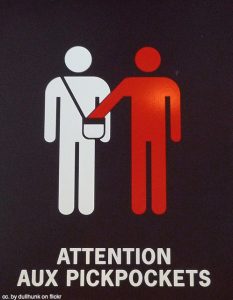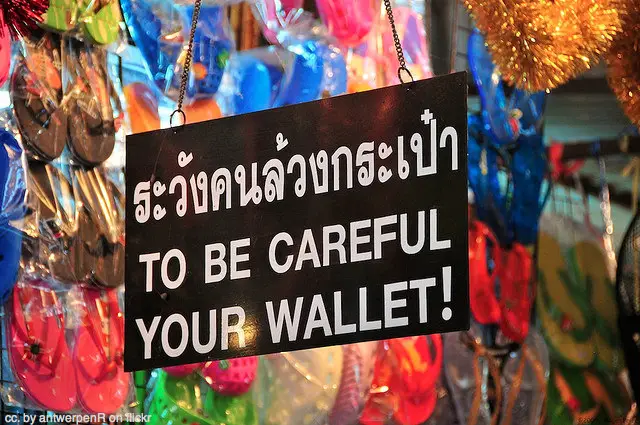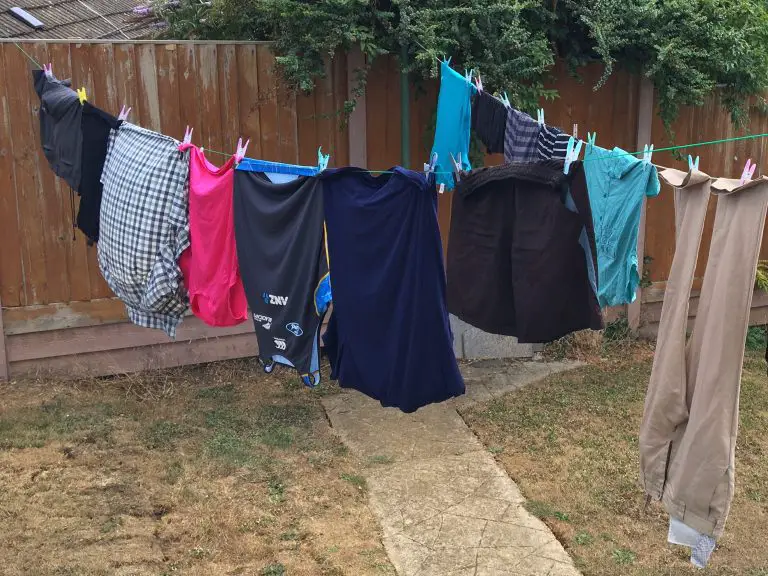How to avoid pickpockets and bag-snatchers as you travel – 12+ Expert Tips
Nothing ruins a holiday like a crime. Here are several expert tips on how to avoid pickpockets and bag-snatchers by security consultant Craig Bidois.
The following is an excerpt from Travel Safety: Safety Tips For Personal And Corporate Travellers by Craig Bidois with Craig Martin.
Evading Street crime and opportunists
If you are unlucky enough to have any problems with criminals during your travels, it’s likely to be with opportunists: pickpockets and petty thieves who are after an easy, non-violent way to separate you from your valuables. In five years of full-time travel in fifty countries, pickpocketing has been the most common criminal problem we’ve encountered. And in five years, it has only happened to us twice.
How to Avoid Pickpockets

This advice will help you stay clear of most pickpockets.
- Always stick to well-lit and busy areas, but avoid public transport and stations during rush hour.
- Don’t wander around with a map or guidebook in your hands: if you get lost, duck into a café to get your bearings.
- If you’ve only got today’s cash in your wallet or pocket, you won’t lose much. Some people carry a dummy wallet in their back pocket, while their real one is zipped inside a jacket pocket or carried in their front pocket.
- Don’t carry, or show, valuable things in poor areas. Leave jewelry and electronics locked in a safe, not on display.
- If you use a money belt to store valuable documents and cash, keep it secret and keep it safe.
- Be especially alert in markets and, if anyone bumps you, check for your wallet… they might be that good.
- If you can handle the fashion faux-pas, consider buying trousers with zippable pockets: they make it that much trickier for pickpockets.
- Always lock bags with a sturdy padlock, and carry backpacks or messenger bags in front of you in high-risk areas.
Best Bags to Avoid Bag Cutting and Pickpockets

When pickpockets can’t find their way into your bags through the normal methods of sliding open zips, they might take the risk of slicing open the bottom of your bag with a knife. This is often done in small groups, with many hands making quick work of all your possessions as they fall to the ground.
To deter this type of theft:
- Use a bag with hefty material, rather than lightweight nylon or silk bags.
- Carry the bag in front of you, rather than on your back.
- Don’t be seen to be putting valuable things into the bag and, if you are carrying laptops or electronics, put them into suspended pockets within the bag, rather than in the main compartment.
- Putting something bulky like a jacket in the bottom of the bag might stop things from falling out if it is cut open.
Some companies, such as PacSafe, produce bags with “slash-proof” features but you pay for this security with a significantly weightier bag.
Snatch and run
Snatch-and-run crimes are more aggressive but normally non-violent. In these cases, the criminals will cut a strap, pull sharply to break a strap, or simply make a grab at a loose item such as a purse, smartphone, or camera — then run.
They might have partners to distract you or to slow down a chase, or they might use a motorcycle or scooter to race up behind someone and get away almost before you know what is happening.
At particular risk for these crimes are electronics hanging from neck-straps, like DSLR cameras or MP3 players and cellphones on a lanyard. A quick-fingered person running a knife near the back of your neck is never a good thing, and the weight of these electronics means they drop swiftly into their hand.
Messenger bags looped from one shoulder are also at high risk, especially when carried behind you. You’ll notice it going, but might not be able to do much about it.
Motorbike snatch-and-ride
Perhaps the most dangerous snatch-and-run technique is when criminals use a motorcycle or scooter. One person will drive, while the snatcher rides pillion behind them.
They will drive up onto the pavement or target a person walking near the roadside and grab at a loose-hanging bag or handheld purse, relying on the speed of the bike to break any straps. However, occasionally the straps don’t break, and the victim will be dragged along the roadside, unable to disentangle themselves.
It’s very unlikely the criminals will let go of their prize: the tighter you hold, the more value they will assume they have found. Our advice, in this case, is to keep yourself as unharmed as possible: let go, get out of the straps, and do whatever you must to avoid being dragged behind the vehicle.








I imagine some of these crimes are more prevalent in some parts of the world than others. My mother had her bag snatched aggressively back in Sydney one time though. Wow! I always pictured the more complicated, social scams were the ones I’d have to keep my wits about for.
Sorry to hear about your mum!
The style of crimes definitely changes as you travel. It’s kind of interesting to look at from a sociological level.
Thanks for this nice summary. I’ve got a great story from my time in Spain in 2009: truly a picture of God providing, if you ever want to hear it.
If it’s on topic, type away 🙂
Great advice! I have never been pickpocket, but my mom was once when getting on a train. You really need to be careful in crowed situations
Sorry to hear that, Jade! It’s such a horrible feeling.
It can be hard to balance awareness of possible threats with having a good time. That’s why we’ve created little habits for ourselves that make this kind of petty theft less likely.